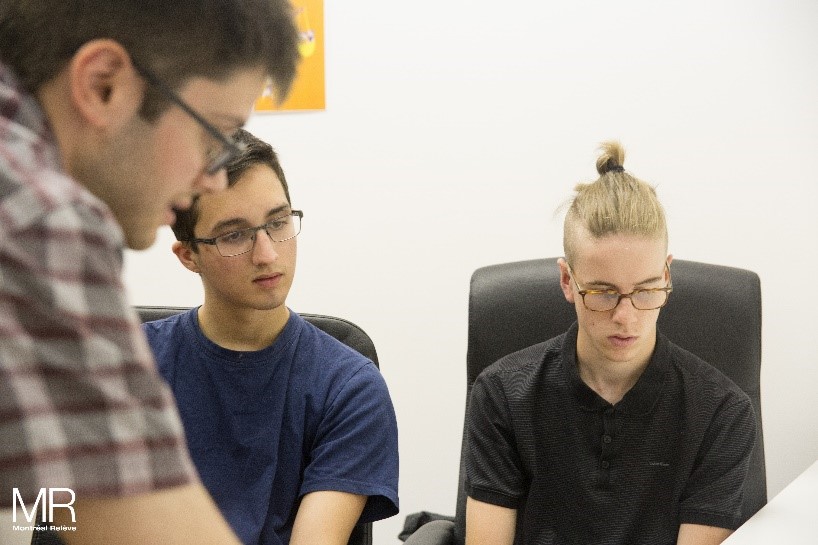The Canadian National Institute for the Blind (CNIB) highlights on its website that “Today, working with someone who is blind or partially sighted is really no different than working with anyone else.” However, according to a study conducted by the organization in 2016, of the 500,000 Canadians who live with this disability, only a third of those able to work can find a paying job. Why? It’s mainly because of a lack of experience with this clientele, says Montréal Relève, an organization who set up the Vision Carrières program to resolve this issue.
The two main concerns
“People living with a visual impairment are among the most educated in our society because, at university, everything is set up to overcome certain disabilities,” explained Marie-Élaine Normandeau, Director of Montréal Relève. This personalized support is very different from the reality of the job market. “The organizations that we are contacting within the scope of the Vision Carrières program are not unwilling to hire qualified people, but they don’t know what accommodations are necessary to receive them.” It’s one of their first concerns. And yet, these arrangements are easy to apply and don’t cost much, according to CNIB. Moreover, resources exist to support companies in this endeavour, including RAMQ’s reimbursement of the cost of materials. [1].
The second concern: companies can be under the impression that someone without a visual impairment will be easier to train and will be effective more quickly. According to Ms. Normandeau, this is a myth. “We helped several organizations experience this: as soon as the installations are set up to receive employees with a disability, they are as effective and, in the end, autonomous as anyone else. They have the same knowledge as their colleagues and have lived with their disability every day. When all is said and done, they’re the ones who do a lot of the adaptation work, just like they do in their daily lives.”
Faced with these preconceived notions, someone who is visually impaired can be afraid to bring up their disability. “Some candidates will not let it show—on the cover letter or in the interview—if the impairment is minor,” explained the director of Montréal Relève. In this respect, there is still work to do to raise awareness.
Internships to help people understand each other


It’s in this context that Montréal Relève—with the support of the CISSS de la Montérégie-Centre, the Institut Nazareth et Louis-Braille (INLB) and the Fondation En Vue—established the Vision Carrières program in 2014. “The goal is to pair a person living with visual impairment with a company. At the end of the internship, the organization usually realizes on its own that it isn’t very complicated to receive an employee with a disability,” explained Marie-Élaine Normandeau.
This job exploration program is offered to teens and young adults. In total, about fifteen internships are set up every year. “We create a link between the university environment, which is very supportive of students, and the professional world, which is less in touch with situations involving disabilities,” stressed Ms. Normandeau.
Vision Carrières helps this future workforce have a first positive experience in a professional environment, be confident in itself and know how to approach disability constructively with a business, while also being supported by specialists.
Being open to difference: a few tips
When someone living with a visual impairment is hired, what can the company do to help him or her integrate?
Talk with new recruits about their needs
“It is important to openly discuss the person’s needs in order to overcome the possible difficulties in fulfilling his or her duties because of disability. He or she is the best placed to inform us and often knows the relevant solution.”
- Jasmine Ugnat, Advisor, Development of Potential, Human Resources, City of Pointe-Claire
Raise awareness in your team so that it can be quick to adopt good behaviour: Explain the new employee’s disability and what that means at the operational level, and answer questions. Also, invite the employee to speak about his or her impairment and to point out what he or she can and can’t see.
Adapt the position to the disability by setting up the necessary installations. To limit risks, for example, make sure the hallways are clear and there are no wires in the way.
Match the new employee with a mentor for the time it takes for his or her integration.
Do a tour of the organization, like with any employee. It is possible to do this visit with an orientation and mobility specialist, as Vision Carrières does for its interns. This specialist will move around with the employee to delineate the path he or she will take every day.
Express yourself verbally. A lot
Read further: Seeing beyond vision loss
Photo credit : Montréal Relève.
[1] Embaucher une personne vivant avec une perte de vision, mythes et réalité.